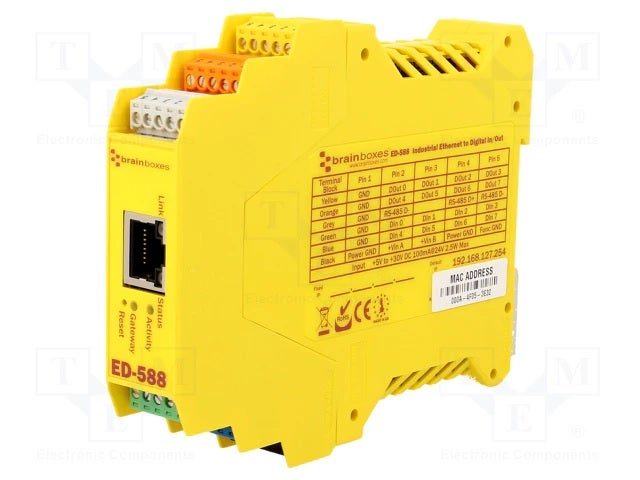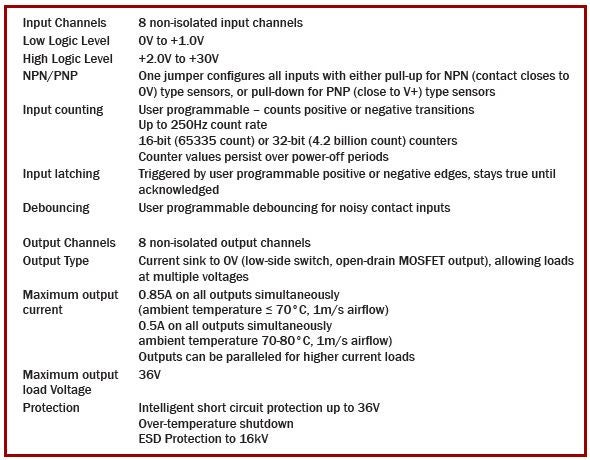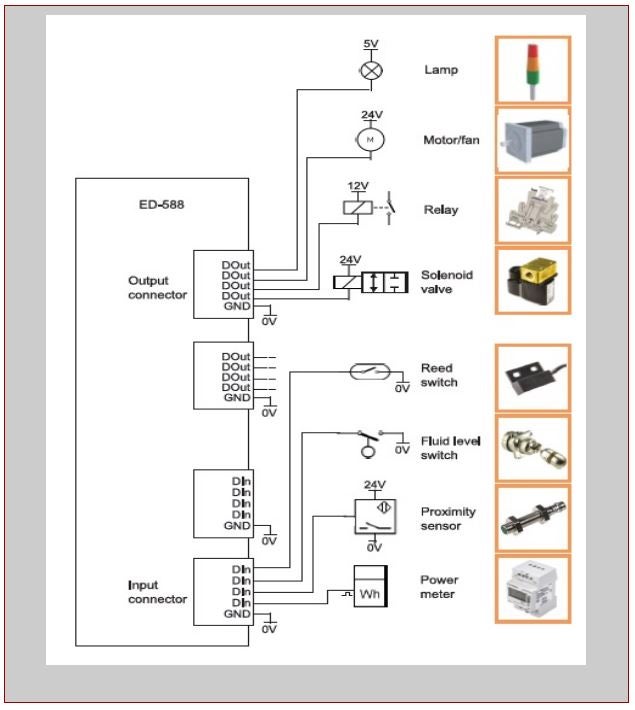
ED-588 Brainbox Ethernet gateway
The pervasiveness of industrial automation technology is set to gain heightened momentum in the years ahead. A report recently published by analyst firm Markets and Markets predicts that the global industrial Internet of Things (IIoT) business will rise from an annual revenue of $77 billion in 2021 to $106 billion in 2026. This represents a 6.7% compound annual growth rate (CAGR) over that period of time.
Jupiter Research gives us some idea of the scale involved. It estimates that there will be a total of 36.8 billion IIoT nodes in operation by 2025 – which is more than double the figure that were operating in 2020. The data being generated by all these nodes would put a huge strain on network infrastructure if all of it had to be sent to the cloud, leading to considerable congestion. Finding solutions to these issues requires an understanding and consideration of the additional costs and power consumption that will result. An alternative to relying solely on the cloud for data processing and storage is to leverage the power of edge computing in industrial environments. The ED-588 Brainbox, from Brainboxes, Ltd., a leader in creating networking equipment and products, is designed to enable you to leverage the advantages of this technology.
ED-588 Brainbox: Specifications and Applications
The ED-588 is an Ethernet gateway with the following major specifications.

ED-588 brainbox specifications
As shown above, this networking device provides a range of operation options; including various power supply levels and multiple inputs and outputs that may be configured to control or drive discrete external systems. Understanding the capabilities offered by the ED-588 is best appreciated by examining the challenges faced by industrial product manufacturers.
Challenges of Industrial Processing
All of us should now have a good grasp of what Industry 4.0 is about, and how it will be reliant on the acquisition and subsequent analysis of huge quantities of data. Through this, it will be possible to improve the production output of manufacturing facilities and raise product quality levels too. Access to data on the performance of equipment and its constituent parts, derived from distributed IIoT devices, will also benefit predictive maintenance. Consequently, the places where repair and component replacement are going to be necessary can be identified early on – before they cause a malfunction that interrupts the workflow and results in unwanted cost penalties being accrued.
A decentralized arrangement of this kind will mean there are no latency issues to contend with, as processing will be carried out closer to the source of the data itself. It also means that bandwidth overheads can be significantly reduced, as a far smaller proportion of captured data will need to be transferred over to the cloud. Generally, it will only be the data that is concerned with the identification of long-term trends and such like that needs to be sent back there. From this it will be possible for processes to be improved in order to help boost productivity, reduce wastage and increase profit margins.
Benefits of Edge Computing in Factories
Industrial edge computing will allow decisions to be made within a shorter timeframe, with less risk of equipment getting damaged or staff being put in danger. Available bandwidth will not be used up, thereby keeping running costs and power budgets down. It will permit direct interfacing with the facility’s enterprise resource planning (ERP), so that operations can be more effectively managed and adapted to changing circumstances. Finally, by retaining most of the data handling locally, many of the potential security threats posed by malicious parties may be mitigated.
If this objective is to be achieved then highly reliable communication and processing hardware is needed. This hardware must leverage smarter technology than the programmable logic controllers (PLCs) that have traditionally been used. It must also be less bulky, offering intuitive operation, ease of integration, re-configurability (to enable different prospective situations to be addressed) and greater interoperability (so that it can work with other items of installed hardware). Alongside these facets it should have exceptional degrees of durability. Among the items called for will be communication cards that are compatible with the relevant legacy bus types (such as Modbus and Profibus), gateways to connect these with higher speed networks, lightweight panel computers, industrial modules, etc. The ED-588 provides a solution to these IIoT challenges. An example of how this advanced device can be implemented is shown below.
 Example implementation of the ED-588
Example implementation of the ED-588
Optimizing Your ED-588 Implementation
An exclusively cloud oriented approach to industrial automation will evidently not be adequate when real-time responsiveness is mandated. What is needed is a combination of this with edge-based processing – as this will accelerate reaction rates and avoid traffic congestion, while also keeping down the associated operational costs. Realizing these objectives is best achieved by following guidelines, as listed below.
|
How to Optimize ED-588 Brainbox Utilization
|
There is a wide range of different items of hardware that can be employed for this purpose and, by engaging with a well-known distributor; such as TME Electronics Components, that has all the necessary experience in this area, the right solution for any given application criteria can successfully be sourced.
If you’re looking for CAD models for common components or important design information for advanced products like the ED-588 Brainbox, Ultra Librarian helps by compiling all your sourcing and CAD information in one place.
Working with Ultra Librarian sets up your team for success to ensure streamlined and error-free design, production, and sourcing. Register today for free.








